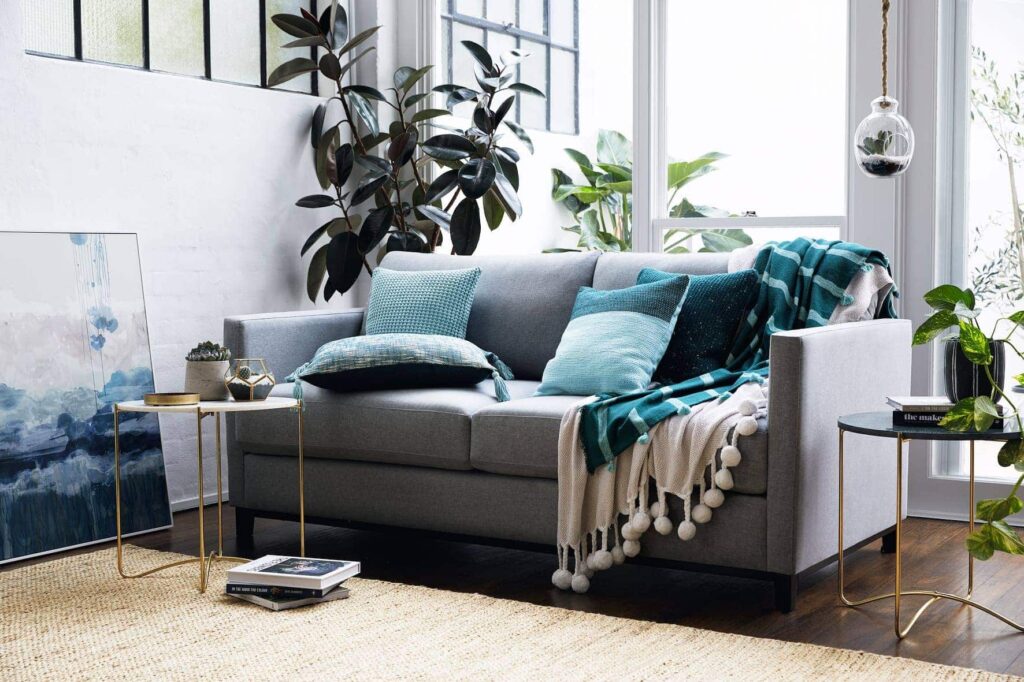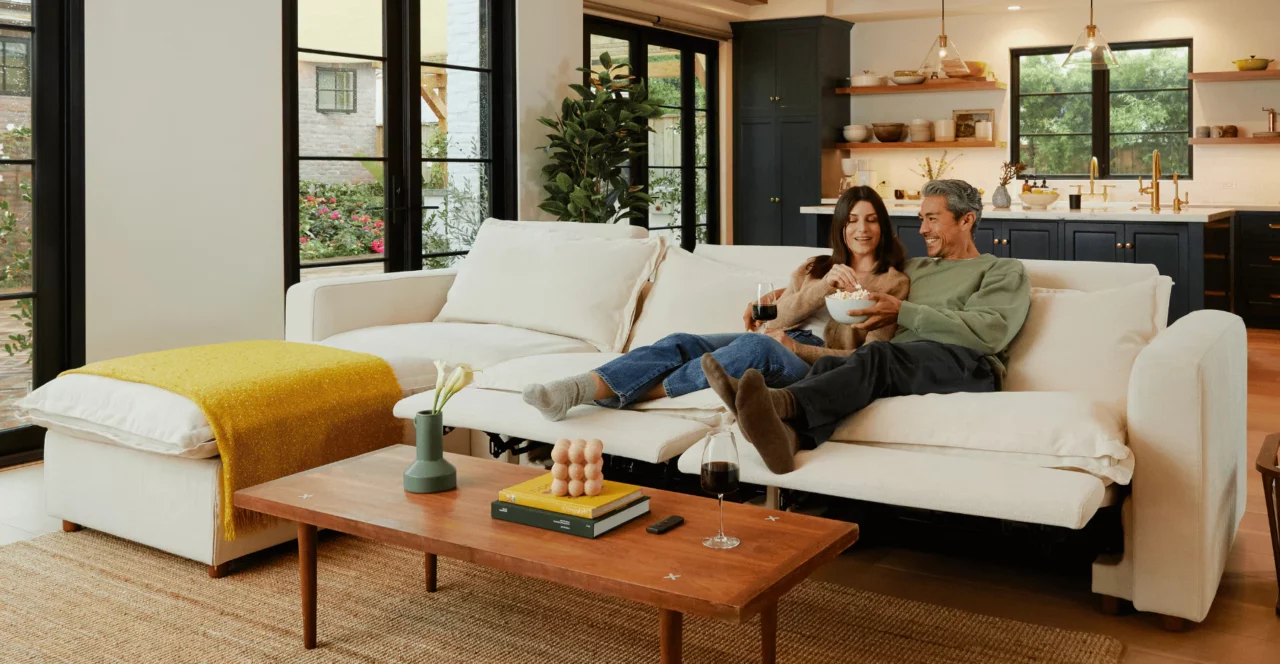Adding a chaise sofa to your living room can transform your space into a luxurious retreat. Known for their versatile design and unparalleled comfort, chaise sofas blend elegant aesthetics with functional seating. This guide will delve deep into understanding chaise sofas, what to consider before purchasing, style options, maintenance tips, and how to maximize the use of your chaise sofa.
Understanding the Chaise Sofa
Chaise sofas are unique pieces of furniture that combine a chaise lounge with a traditional sofa. This blend allows for both reclining comfort and ample seating, making it an ideal choice for relaxation and entertaining. Their design not only enhances physical comfort but also adds an element of sophistication to any living space, making them a popular choice among homeowners and interior designers alike.
History and Evolution of Chaise Sofas
The word “chaise” comes from the French term “chaise longue,” which translates to “long chair.” Historically, chaise lounges date back to ancient Egypt, where they were depicted in art as pieces for reclining. Over the centuries, the design evolved, gaining prominence during the 18th century in French aristocracy. During this period, they were often upholstered in luxurious fabrics and adorned with intricate carvings, reflecting the opulence of the time.
Today, modern interpretations of chaise sofas showcase a variety of styles, materials, and sizes, accommodating diverse tastes and decor themes. The evolution has made this piece not just a relaxation spot but also a focal point in interior design. With the rise of minimalism and contemporary aesthetics, chaise sofas are now available in sleek designs with clean lines, often featuring materials like leather, velvet, or eco-friendly fabrics, appealing to a wider audience seeking both comfort and style.
Key Features of a Chaise Sofa
Chaise sofas come with several distinctive features that add to their appeal. Typically, they have an extended seat that allows one to stretch their legs comfortably. Many models are designed with multiple cushions, enhancing comfort and support. The cushions can vary in firmness, allowing users to choose a configuration that best suits their lounging preferences, whether they prefer a plush, sink-in feel or a firmer support.
Additionally, chaise sofas often feature adjustable sections, making them versatile for various seating arrangements. They are available in various shapes, from L-shaped to U-shaped, catering to different room layouts and personal preferences. Some designs even incorporate built-in storage solutions, providing a practical aspect to their aesthetic appeal. This functionality makes chaise sofas not only a stylish addition to a room but also a smart choice for maximizing space, especially in smaller living areas where every inch counts.

Factors to Consider When Buying a Chaise Sofa
Purchasing a chaise sofa is a significant investment, so it’s essential to consider various factors before making a decision. These considerations will help ensure that the sofa complements your space and meets your needs.
Size and Space Requirements
The first step in choosing a chaise sofa is determining the size of the space where it will be placed. Measure the area to ensure the sofa fits comfortably without overpowering the room. Additionally, consider the layout of your space and how the sofa will interact with other furniture pieces.
Take into account the size of the chaise’s extension. If the chaise extends into a walkway or blocks access to other furniture, it might not be the best fit for your home. Aim for a well-balanced arrangement that promotes flow and accessibility. Moreover, think about the overall style of your room; a chaise sofa can serve as a focal point, so its size should harmonize with other elements, such as coffee tables, rugs, and accent chairs, to create a cohesive look.
Material and Durability
The material of your chaise sofa is not just about aesthetics; it affects the sofa’s durability, comfort, and maintenance. Popular materials include leather, microfiber, and various fabrics. Each material has its pros and cons.
Leather: Offers a classic look and is easy to clean, but can be pricey and less cozy in colder climates.
Microfiber: Known for its stain resistance and comfort, making it a practical choice for homes with pets and children.
Fabric: Available in a vast array of patterns and textures, but may require more maintenance depending on the type.
When selecting a material, also consider how it will hold up over time. For instance, high-quality leather can develop a beautiful patina, while certain fabrics may fade or wear more quickly in direct sunlight. Additionally, if you have allergies, look for hypoallergenic materials that are less likely to harbor dust mites and other allergens, ensuring a healthier living environment. Read more about material and durability at https://sustain.dtu.dk/en/forskning/materials-og-durability
Comfort and Support
Comfort is paramount when choosing a chaise sofa. Look for sofas that offer adequate support for your back and legs. Test the sofa in-store and pay attention to the cushioning; it should provide comfort without being too soft or too firm.
Additionally, consider the seat depth and height. A deeper seat may provide a more relaxed lounging experience, while a higher seat can be more supportive for those with mobility issues. Always try out the sofa beforehand to ensure it suits your comfort preferences. Furthermore, think about the armrest height and design; some chaise sofas come with adjustable or removable armrests, which can enhance your lounging experience, allowing you to find the perfect position for reading, watching TV, or simply unwinding after a long day.
Style and Design Options for Chaise Sofas
Chaise sofas come in a wide range of styles, allowing you to express your personal taste in your living space. It’s crucial to find a sofa that complements your existing decor while also satisfying your unique style preferences.
Traditional vs. Modern Chaise Sofas
Traditional chaise sofas often feature intricate woodwork, rich fabrics, and classic patterns. They tend to evoke a sense of elegance and are perfect for more formal settings. On the other hand, modern chaise sofas emphasize minimalist designs with clean lines, neutral colors, and innovative materials.
Choosing between traditional and modern styles depends on your existing room decor and personal preference. You might even find a hybrid style that offers a contemporary look with classic elements. For instance, a modern chaise with a tufted back can blend the charm of traditional design with the sleekness of contemporary aesthetics, making it a versatile choice for various interior themes.
Choosing the Right Color and Pattern
The color and pattern of your chaise sofa play a significant role in your room’s overall aesthetic. Neutral tones like grays, beiges, and whites are versatile and can easily fit into any decor scheme. However, vibrant colors can act as a statement piece, adding personality to your space.
Consider the existing color palette of your room while selecting the sofa. If your room features bold hues, a contrasting chaise sofa can lend balance. Additionally, if you prefer patterns, ensure they match well with other elements in your decor, such as curtains and throw pillows. Floral patterns can bring a touch of nature indoors, while geometric designs can add a modern twist. Furthermore, textures such as velvet or leather can enhance the visual interest and tactile experience of your chaise sofa, making it not just a piece of furniture but a focal point in your living area.
When selecting a color, think about the mood you want to create. Softer shades can evoke a sense of calm and relaxation, perfect for a cozy reading nook, while bolder colors can energize the space, making it ideal for entertaining guests. Additionally, consider the lighting in your room; natural light can change the appearance of colors throughout the day, so it’s wise to test fabric swatches in different lighting conditions before making a final decision.
Maintenance and Care for Your Chaise Sofa
Once you’ve made your investment, maintaining your chaise sofa is essential to ensure its longevity and appearance. Different materials require different care routines, so understanding how to care for your sofa will keep it looking its best.
Cleaning and Upholstery Care
Regular cleaning is vital for upholstery to prevent dust and dirt buildup. For fabric sofas, vacuuming with a soft brush attachment will help remove surface debris, while spot cleaning can tackle minor stains. Always refer to the manufacturer’s cleaning guidelines to avoid damaging the fabric.
Leather sofas also require specific care. Regular dusting and the use of leather conditioners every few months can keep the material supple and prevent cracking. Be sure to use products designed specifically for leather to maintain its integrity. To learn more about general upholdstery care click here.

Long-Term Maintenance Tips
Easily overlooked, long-term maintenance is crucial for preserving the quality of your chaise sofa. It’s advisable to rotate cushions regularly to distribute wear evenly. This practice helps maintain the shape and comfort of both the seat and back cushions.
Additionally, try to avoid direct sunlight exposure which can fade colors and damage fabrics over time. Consider using window treatments that minimize UV exposure, and periodically check your sofa for any signs of wear or damage to address them promptly.
Making the Most of Your Chaise Sofa
Once you’ve chosen the ideal chaise sofa, you can enhance its functionality and style with strategic positioning and appropriate accessories. The ways you utilize your sofa can significantly impact your living space’s comfort and aesthetic appeal.
Positioning Your Chaise Sofa
Positioning your chaise sofa strategically can create a welcoming atmosphere. Consider placing it in a corner for a cozy nook or against a wall for a more open feel in the room. If your space allows, angling the sofa can create an inviting flow and encourage conversation.
Also, think about sightlines within the room. Ensure that the chaise does not block views or pathways. The goal is to create a harmonious arrangement that complements the room’s overall design and functionality.
Accessorizing Your Chaise Sofa
Accessorizing is a great way to elevate the style of your chaise sofa. Throw pillows in various sizes and textures can add visual interest while offering additional comfort. Choose patterns and colors that echo your room’s theme.
A soft throw blanket can also enhance the cozy aesthetic while providing warmth during colder months. For added flair, consider a stylish side table next to the chaise for convenience, and ensure your accessories reflect your personal style.
In conclusion, investing in a chaise sofa not only enhances the comfort of your space but also adds a stylish touch. By understanding the features of chaise sofas, considering important factors, exploring style options, and maintaining your sofa, you can ensure that your chaise becomes a cherished centerpiece in your home.
Related : Discover Why a Chaise Sofa is the Perfect Addition to Your Living Space

